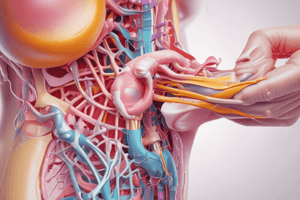Podcast
Questions and Answers
What is a common sign of endometritis that may appear one day postpartum?
What is a common sign of endometritis that may appear one day postpartum?
- Temperature of 102° (correct)
- Absence of uterine tenderness
- Clear lochia
- Decreased white blood cell count
Which position should the patient be placed in to aid in the drainage of infected lochia?
Which position should the patient be placed in to aid in the drainage of infected lochia?
- Prone position
- Sitting position
- Fowler's position (correct)
- Supine position
What indicates a severe complication in a patient with pelvic pain?
What indicates a severe complication in a patient with pelvic pain?
- Mild discomfort relieved by medication
- Stable vital signs
- Low body temperature
- Large hematomas requiring drainage (correct)
What is a possible indication of infection spread in a patient with endometritis?
What is a possible indication of infection spread in a patient with endometritis?
Which of the following should be monitored in a patient with severe pelvic pain?
Which of the following should be monitored in a patient with severe pelvic pain?
When should Rhogam be administered to an Rh- mother after giving birth?
When should Rhogam be administered to an Rh- mother after giving birth?
What is the recommended action to prevent venous thrombosis in a patient who is bedridden?
What is the recommended action to prevent venous thrombosis in a patient who is bedridden?
Which of the following actions should NOT be performed to avoid venous thrombosis?
Which of the following actions should NOT be performed to avoid venous thrombosis?
What circumstance requires Rhogam to be given during pregnancy?
What circumstance requires Rhogam to be given during pregnancy?
Which of the following is NOT recommended as a preventive measure for venous thrombosis?
Which of the following is NOT recommended as a preventive measure for venous thrombosis?
What is a key characteristic of the Taking-In Phase for a mother postpartum?
What is a key characteristic of the Taking-In Phase for a mother postpartum?
What nursing response is most appropriate during the Taking Hold Phase?
What nursing response is most appropriate during the Taking Hold Phase?
What is a significant challenge for adolescent mothers as they adapt to motherhood?
What is a significant challenge for adolescent mothers as they adapt to motherhood?
In the Letting Go Phase, what must mothers often reconcile?
In the Letting Go Phase, what must mothers often reconcile?
Which approach is recommended for teaching adolescent mothers to care for their newborns?
Which approach is recommended for teaching adolescent mothers to care for their newborns?
Flashcards
Endometritis
Endometritis
A postpartum complication where the lining of the uterus becomes infected.
Postpartum Fever
Postpartum Fever
A fever of 102°F or higher that develops within a day after childbirth.
Tender, Enlarged Uterus
Tender, Enlarged Uterus
Painful, enlarged uterus that may be tender to the touch.
Pelvic Hematoma
Pelvic Hematoma
Signup and view all the flashcards
Hypovolemic Shock
Hypovolemic Shock
Signup and view all the flashcards
Rhogam: When is it given?
Rhogam: When is it given?
Signup and view all the flashcards
Rhogam: When is it given during pregnancy?
Rhogam: When is it given during pregnancy?
Signup and view all the flashcards
Venous Thrombosis: Prevention
Venous Thrombosis: Prevention
Signup and view all the flashcards
What are SCDs?
What are SCDs?
Signup and view all the flashcards
Avoid pressure where?
Avoid pressure where?
Signup and view all the flashcards
Taking-In Phase
Taking-In Phase
Signup and view all the flashcards
Taking-Hold Phase
Taking-Hold Phase
Signup and view all the flashcards
Letting-Go Phase
Letting-Go Phase
Signup and view all the flashcards
Direct Teaching for Adolescent Mothers
Direct Teaching for Adolescent Mothers
Signup and view all the flashcards
Peer Group Importance for Adolescent Mothers
Peer Group Importance for Adolescent Mothers
Signup and view all the flashcards
Study Notes
Endometritis
- Symptoms: Temperature of 102°F, postpartum, tender and enlarged uterus, prolonged severe cramping, foul-smelling lochia, signs of uterine subinvolution.
- Elevated WBC: Indicates inflammation.
- Treatment/Nursing Care: Administer antibiotics, Fowler's position to facilitate infected lochia drainage, analgesics, observe for abdominal distention, nausea, or vomiting, increase fluid intake.
- Nursing care: Monitor for signs of infection.
Pelvic Pain
- General discomfort: Relieved by medication.
- Hematoma: Severe, unrelenting pain not relieved by medication, concealed blood loss, pulse and respiratory rates may rise, and blood pressure may fall. Potential for hypovolemic shock if large hematomas develop.
- Nursing care: Ice pack, pain medication.
- Report to MD: If severe pain is unresolved, unable to void, or unable to eat. Keep NPO (nothing to eat or drink) until seen by MD.
Studying That Suits You
Use AI to generate personalized quizzes and flashcards to suit your learning preferences.




